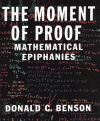Book reviews
Why Do Buses Come In Threes?

This book is subtitled The Hidden Mathematics of Every Day Life, was written by Rob Eastaway and Jeremy Wyndham, and has a forward by Tim Rice. It acknowledges the work of Martin Gardner as a source of inspiration, and has a very jolly cover with red buses and cheerful fridge-magnet style integers on it (Anyone who is or has ever been involved with a pre-school child will know the sort of thing I mean).
The chapter headings are chosen to appeal to the child or the non-mathematician - 'Why can't I find a four leafed clover?', 'Why do clever people get things wrong?', 'why are showers always too hot or too cold?' and other intriguing problems that have been worrying us all our lives. Some of the contents are conundrums we've all ( well, nearly all) met before, such as the Konigsberg bridges, but there's lots of interesting stuff that is right up to date as well. For example - on which day should you buy your lottery ticket, to maximise your chance of winning (I won't give it away - except to say that the answer depends on a comparison of the chances of winning and the chance of being run over by a bus in the same period).
There is a chapter on numbers in biology - with Fibonacci, the golden ratio and a section on 'Pi and the circle'. It also explains why animals don't have wheels - which wasn't something I'd been worrying about.
I would give this book as a present to a child who enjoyed maths, to an adult who liked puzzles, or to a maths teacher who wanted material for those end-of-term lessons when nothing but fun will do. And at �8.99, I could afford to.
- Book details:
- Why do buses come in threes?
- Robert Eastaway, Jeremy Wyndham, Rob Eastaway, Tim Rice
- Paperback - 176 pages (March 1999)
- John Wiley & Sons; ISBN: 0471347566
The Nothing That Is - A natural history of zero.

by Robert Kaplan
It was the Sumerians who first decided they needed a zero. They counted in both base ten and base 60, and needed a symbol to indicate nothing in the 'tens' column, so that they could tell whether the answer was 123 or 23. But they didn't use this useful symbol to indicate the terminal digit, so out of context you can't tell 180 from 30, or from 3.
'The Nothing that Is' is an excellently written and erudite story of ....nothing. Of zero. We discover that many early cultures had no term for it, or saw no need for it. We follow it's progress across the Old World, from early usage in China and India, back towards the west via Arabian merchants, who in turn passed the concept to the Greeks following Alexander's conquest of much of the known world.
We also take a trip across the Atlantic to the culture of the Mayas, who had multiple calendars, and a symbol for zero which was a portrait of the god of death. Why multiple calendars? - Kaplan postulates a societal fear of an Ending, when the end of all the calendar cycles coincide - bringing a total End. Having many calendar cycles postpones this event for many years, and in the meantime, when two cycles coincide, the gods can be placated with blood sacrifice. . .
All very interesting, if gory. Kaplan moves from the Maya to (briefly) the obsessive counting many of us have done from time to time. The carriages making up the train, the tiles on the ceiling at the dentist, cracks in the pavement. . .
This book is full of fascinating material and is extraordinarily well written. There are chapters that will appeal more to (in other words 'be understood by') the mathematicians, but plenty to fascinate, amuse and educate the reasonably ordinary literate person. My wife enjoyed most of it - and she's a biologist!
- Book details:
- The nothing that is
- Robert Kaplan
- Hardback - 225 pages (1999)
- Penguin Books Ltd. ISBN: 0713992840
- Book details:
- Why do buses come in threes?
- Robert Eastaway, Jeremy Wyndham, Rob Eastaway, Tim Rice
- Paperback - 176 pages (March 1999)
- John Wiley & Sons; ISBN: 0471347566
The Moment of Proof - Mathematical Epiphanies.

by Donald C. Benson
This is a rare beast - a popular mathematics book that actually contains mathematical proofs and expects its readers to enjoy the experience! Donald Benson wants us all to savour the joy of discovery that mathematicians feel when they first encounter an elegant proof.
You might by now be wondering whether the author was successful in this aim. Often he is. On a few occasions he really expects us to do too much work and mathematical rigour gets in the way. Nevertheless the book really does have its 'moments', and I would recommend it unreservedly to anyone in need of inspiration or a good example for their next lesson!
The Moment of Proof also works as a reference text. There's a good index and bibliography, and a sufficiently eccentric choice of proofs to make it the one you reach for when you need something different. Go and buy a copy!
- Book details:
- The Moment of Proof
- Donald C. Benson
- Hardback - 331 pages (1999)
- Oxford University Press. ISBN: 0195117212